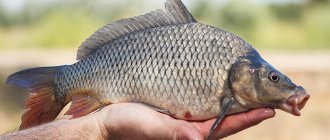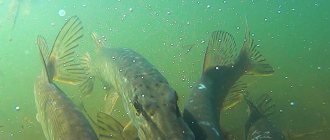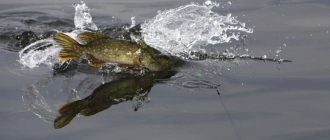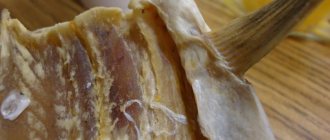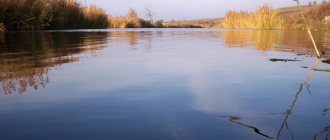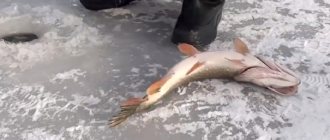There is probably not a single person who is not familiar with such a freshwater fish as pike. But only a few really understand its lifestyle, habitat, and methods of fishing. Within the framework of this material, we eliminate all gaps in knowledge.
Pike is a species of predatory freshwater fish of the pike family. Distinctive features are a torpedo-shaped body, a huge head and a wide mouth. The teeth located on the lower jaw are responsible for capturing the victim, therefore they have the shape of fangs and vary in size. The teeth on the upper jaw are smaller with points facing inward. Pike can reach 1.5 meters in length and weigh up to 35 kg - although this is a rare occurrence. Females are usually larger than males. The color primarily depends on the habitat and can have a gray-green, gray-brown or gray-yellow tint, the back is darker, with characteristic brown spots forming stripes.
The breadth of vision is ensured by high-set eyes. Excellent vision is complemented by the functionality of the lateral line - an essential organ that responds to the slightest vibrations. All this helps the predator hunt, patiently waiting for prey among the algae. Having identified the victim, the pike swallows the prey with a sharp jerk, always grabbing it by the head.
The lifespan of pike can reach 30 years.
Types of pike
The Pike family has 7 main species of pike. Let's look at each of them:
- The common fish is the most common member of the family, inhabiting most of the water bodies of North America and Europe. Individuals are medium in size, up to 1.5 meters and weighing up to 7-8 kg. You can find such fish in stagnant bodies of water, thickets and coastal areas.
- American - lives exclusively in the eastern part of North America. Quite small individuals, up to 80 cm in length and weighing up to 1 kg. A distinctive feature is a shortened snout and a short life expectancy - only 8-9 years.
- Black (striped) is another representative of the genus that lives in the waters of North America. Outwardly they resemble a common pike, however, they reach a length of no more than 60 cm with a maximum weight of 4 kg. The characteristic mosaic pattern on the sides and the dark stripe above the eyes are a distinctive feature of the species. A comfortable habitat is areas of water bodies with abundant vegetation. The diet of black pikes is mostly represented by invertebrates, which is associated with a peaceful disposition.
- Amurskaya is an inhabitant of the reservoirs of Sakhalin Island and the Amur River, reaching 115 cm in length and weighing 20 kg. This species of pike is characterized by a silvery color of scales, less often golden-greenish. Numerous dark spots on the belly and back make this species look like taimen.
- Southern (Italian) - from the name it is clear that this species lives in the reservoirs of central and northern Italy. For many years it was considered a subspecies of the common pike; it was identified as a separate species only in 2011.
- Aquitaine is a little-known and little-studied species of pike, bred only in 2014. Representatives inhabit fresh water bodies of France.
- The muskellunge is rightfully the rarest and largest species of pike living in fresh American waters. Some specimens reach 1.8 meters in length and weigh about 40 kg, which is truly impressive. Externally, the musky is very similar to the common and American pike, but the sensory points on the lower jaw are a fundamental difference. The giant has a traditional silver, less often greenish tint, its sides are decorated with large stripes resembling spots.
Pike size
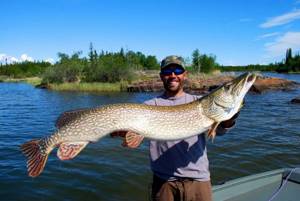
There are real legends in specialized literature about the fantastic size of pike. Just look at Boris Godunov's pike, weighing 130 kg and 6 meters long. Whether to believe these rumors or not is a personal matter for everyone. We will focus on scientifically known and reliable facts.
The largest pike in the world was caught in the mid-30s of the last century on the territory of the USSR, in Lake Ilmen; it reached a length of 2 meters and weighed as much as 35 kg.
To date, scientists have found that the largest pike sizes live in the northern lakes of Russia. It is lakes, not rivers, as many believe. Moreover, the further south you go, the less likely it is to catch a real trophy.
Pike spawning
Pike spawning, as a rule, occurs immediately after the melting of ice covering water bodies in winter, at this time the water temperature warms up to 3-6 degrees Celsius, and the environment becomes most favorable for spawning. Pike is a fish that goes to spawn earlier than others. It is noteworthy that for full development, pike caviar prefers the main condition - cold water saturated with oxygen. As soon as a comfortable temperature arrives, the pike begins to look for a place to spawn - most often these are shallow areas of the reservoir and spills at a depth of up to a meter.
Females are ready for spawning approximately in the 4th year of life, males mature a year or even two later. By this moment, they have already reached 30 cm in length and weigh a little more than 400 g - they are the ones who open the spawning season, a little later they are joined by medium and large pikes, which are the most prolific. After several weeks, the eggs hatch into larvae.
Few people know that fishing for pike during spawning is strictly prohibited; the time of the ban for the water area of each region is determined individually.
What does pike eat?
Pike is a predatory fish that feeds on a wide variety of animal foods. The basis of the pike diet is all kinds of fish. Already, pike fry, whose size barely reaches 1.5 cm and the basis of their diet is zooplankton, are trying to hunt the larvae of various small fish. Having reached a size of 5 cm, pike completely switch to feeding on fish.
Pike are not particularly picky about their diet; they eat whatever they can catch. Among the fish, pike prefer: crucian carp, roach, bream, silver bream, perch, goby, whitefish, bream, roach, ruffe, gudgeon, char, and minnow.
You might be interested in: Trout tune. Killer melody
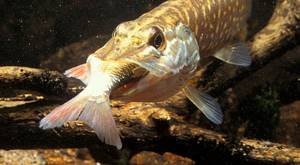
Pike treats ruffs, perches and pike perch with caution, which have sharp fins and can injure the pike with them. Pike does not really like burbot and tench because of their unpleasant mucus. Having caught a ruff or perch, the pike squeezes it with its jaws for a long time until it feels that its victim has completely stopped resisting and only then swallows it.
Pike often eat other pike if they are smaller in size. Anglers often catch large pike weighing up to 4 kg, with lacerations on their sides. Such wounds indicate that there are even larger pikes in the reservoir, and the caught pike became a victim of their attack. A pike weighing 15 kg, which is 20-25 years old, can eat another pike weighing 8 kg.
In spring and the first half of summer, pike happily eat frogs and molting crayfish. In autumn, during migration, various rodents (mice, rats and squirrels) swim across rivers and often become prey for large pikes. A large pike can grab and drag a duckling, and sometimes even an adult duck, under water, especially during molting, when the duck has difficulty rising into the air. Cases are mentioned when pikes even grabbed geese.

The gluttony of the pike is evidenced by the fact that it is able to swallow food reaching a size of 50-65% of its own weight and size.
Having caught the prey, the pike turns it head first and then swallows it; if the pike cannot swallow its prey completely, it waits until the swallowed part of the prey is digested and then swallows the rest of the prey.
Food in the stomach of pikes is digested very slowly, which is why pikes are so voracious, they have to fill their digestive tract completely to capacity. The pike regurgitates scales and other solid undigested food debris.
Pike feed irregularly; after eating, the pike can digest food for several days and not hunt during this entire time.
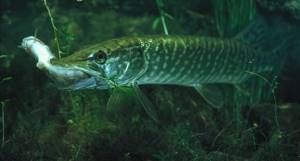
The time when pike are actively feeding is commonly called zhor by fishermen. There are three periods of pike feeding: pre-spawning feeding occurs in early spring, post-spawning feeding occurs in April-May, and autumn feeding occurs in the fall with cooling temperatures.
The time of active feeding can be determined by the behavior of the pike. During zhora, the pike often jumps out of the water and starts a fry fight, during which the fry jumps out of the water in different directions. It happens that, carried away by the pursuit of a fry, a pike even jumps out onto the shore during a feast.
Pike habitats
Pike is the most common predator when it comes to the inhabitants of the reservoir. There is enough space in the river for its full life activity. Snags, coastal bushes and trees, sand spits and bridges are places with excellent food supply for pikes, which contributes to their long stay.
Let's look at the places where pike fishing is best:
- Snags - this environment is represented by flooded trees, fallen branches, logs, slowing down the flow of water and creating natural differences in depth. Woody remains and debris become not only a source of food, but also an excellent shelter, allowing the predator to hunt.
- Shallow water with thickets - as soon as the ice melts from the reservoir and the water warms up to the optimal temperature, the fish begin to leave their wintering holes. So it is in the direction of shallow water, where the water warms up faster, that the first representatives head. The fish thrive in dense thickets of grass.
- Sandy spits - the predator follows the spits mainly in the morning and evening, which must be taken into account when planning fishing. And there is a simple reason for this - it is at this time that there is a huge amount of small fish, which become excellent prey for a predator.
- Backwaters are another attractive habitat for pike. All kinds of artificial canals and creeks that impede the natural flow of water have always attracted predators. Particularly loved are pits where there is practically no current.
- Bridge zones - at the base of the bridge the current breaks up, creating some kind of vortices. Such places are ideal for peace-loving fish - the food of pike. The predator hides perfectly in the shadow of the bridge, which ensures an instant and effective attack.
Pike lifestyle
The choice of habitat is largely determined by the sedentary lifestyle of the predator. Thickets of pond vegetation are an excellent place to wait for their prey. Most of the time, the pike simply stands motionless, but when it spots a prey, it accelerates and attacks with lightning speed. It is noteworthy that no matter from which side the pike captures its prey, it always swallows it from the head, first turning it around if necessary.
Even large adult individuals choose shallow water to live. There are cases in history when very large specimens were caught at a depth of only 40-50 cm. A prerequisite for a long life for pikes is an abundance of oxygen in the water, which is why pikes die in shallow bodies of water, especially in winter.
Pike always waits for its prey where there is cover. Even large individuals living at depth will definitely find algae or snags to hide behind. On sunny days, fish go out into shallow water to bask in the rays of the sun.
Pike tolerates proximity to other individuals; they hunt in turns: while one is digesting food, the others are in ambush. Adults prefer solitude, gradually eliminating their smaller counterparts from the area of the reservoir. The large pike has practically no enemies, with the exception of humans, so in fresh water bodies it rightfully feels like a queen.
How pike hunts. Pike habits
In many reservoirs, being tied to certain areas of the coastal or deep zone, pike attacks prey mainly from ambush. Where there is not enough vegetation, stones and other irregularities of the bottom, the pike sneaks up to the places of concentration of forage (let's call it that) fish, choosing a position for a short throw, or catches it after it.
Regardless of the nature of the reservoir, pike hunt by stalking or chasing during periods of the most intense feeding: in the spring, when most fish spawn, and in the fall, during the mass movement of fish from the coastal zone to deeper, warmer waters. The possibility of ambush hunting decreases in the cold months of the year, when the number of shelters is reduced by more than half (vegetation settles to the bottom).
Some literary sources claim that the pike makes sudden attacks on its prey from an ambush only over short distances and, if unsuccessful, returns to cover.
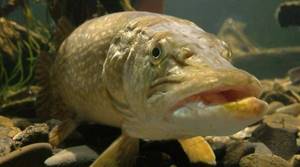
However, from the observations of fishermen, it is known that sometimes, in the same conditions when a pike can camouflage itself in natural ambushes, it pursues the prey at a considerable distance, at the very top of the water and with such excitement that sometimes it throws itself ashore. It remains a mystery why in some cases the predator hunts for easy prey with a lightning-fast throw from an ambush, while in others it is forced to spend a lot of energy pursuing the prey, with little chance of success. This is all the more surprising since the pike is a typical “sprinter”, and when “running” over long distances, and even along a curve, it most often fails. Only in rivers with a sufficiently strong current does the pike have phenomenal agility, allowing it to overtake even such a fast, resourceful fish as dace.
I have only observed prolonged chases of pike after prey in the upper layers of water only in the warm months of the year and only in cloudy weather. True, with a significant decrease in illumination, when low dark clouds passed over the reservoir, I did not notice such chases.
So, the hunting methods of pike apparently depend on the degree of transparency and illumination of the water. The water temperature also plays an important role, as it decreases the predator becomes lethargic.
A “working” ambush for pike is the border of algae with clear water, boulders and large stones, flooded bushes and trees, sunken snags, and in autumn and winter - deep edges and other bottom irregularities. In an ambush, the predator shows amazing restraint.
However, any ambush can only make sense if young fish periodically accumulate or move around it. Therefore, in summer, when the water is warm, the predator, as a rule, hides at relatively shallow depths, where it is more likely to wait for prey.

But here we must take into account: if an angler casts a spoon or other bait only along the lines of expected pike ambushes, he cannot always count on success. The fact is that in good weather and at times not associated with the hot midday heat, forage fish stay not only in the grass strip, but also on streams of clean water, on riffles and fords free of algae, near fast streams near dams and sluices , mouths of streams and rivers.
In rivers and lakes there are vast stretches with dense soil, on which there are no or very few plants and other shelters for pike, but there is depth, and on rivers there is a special “warehouse” of flow. There are a lot of fish feeding in such places, so you can count on stray predators biting here.
As a rule, pike live and hunt alone, but there are situations when individuals of approximately the same age and size stay together, sometimes even as a whole group. Predators resort to such proximity when there are enough forage fish in one or another part of the reservoir, and there are much fewer ambushes, including multi-tiered ones, than there are pikes. This also happens during wintering, when there are not enough pools, holes, etc. But even in wintering pits, where sometimes large “teams” of pike gather, they stay away from each other.
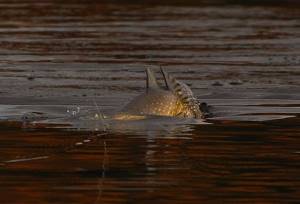
...But the conditions changed: a dam was built on the river, the water slowed down and overflowed, flooding a large area. A reservoir was formed over a vast area. How does the pike behave here?
In the reservoirs of the Moscow region associated with the Moscow Canal, as well as in the Istrinsky and Mozhaisk reservoirs, a large number of pike appeared already in the first years of their existence. They were hungry, they were caught at any time, using any lure or live bait. Pike ambushes remained at depth, in the flooded river bed, while the food fish were dispersed throughout the entire reservoir, and shelters in the thickets on new shallows did not appear everywhere. So hunting for pike became very difficult. It was in this situation when fishing with a spinning rod that I more than once had to observe group attacks of pike on a school of juveniles. I'll tell you about several such cases.
On the Istra Reservoir, before the confluence of the Katysh River, there is a deep hole on one side of the mouth, and a wide sandbank on the other. Once, for a long time and unsuccessfully, I fished this hole with a spoon, trying to move the bait closer to the steep changes in depth. And suddenly I hear splashes of large fish behind the boat. On the nearest 30-40-meter section of the shallows, furrows, breakers and craters appeared in many places at once from the turning of hunting predators. This lasted two to three minutes, during which I managed to bring the boat closer to the battle site and catch two pikes of almost the same size. After that the bite stopped.
I observed another case of joint hunting of pikes on the shallows near the forest shore of the Klyazma Reservoir. The snagged slopes of this shallows descend 9-12 m into the flooded bed of the Klyazma River.
After the heavy rain, which we waited out on the shore, my friend noticed several splashes of large fish on the shallows, from which the juveniles, jumping out of the water, tried to escape. We rowed the boat to the outer edge of the shallows, bordering the deep water. The disturbed fish disappeared, there was silence, but on the ridge of the shallows, on the first or second meter of descent into the depths, our lures were grabbed almost simultaneously by predators. Pike! And soon in the same place, one after another, we caught several spotted predators.
Group hunting of pikes is observed from time to time in some rivers and lakes, and sometimes it depends on the size of the predators. For example, in the book “Fish Tracks” M. Zaborsky wrote: “Large predators hunt alone, sometimes in pairs, and smaller pike, up to two kilograms, hunt in small parties, up to a dozen.”
The interesting behavior of some fish living in the remote taiga lakes of the Arkhangelsk region is described in the essays by A. Onegov “Traces on the Water.” The author writes that in good weather, when a flock of roach walks in the upper layers of water, they are always accompanied by predators along the entire path. It turns out to be a game of “shepherds and flock”.
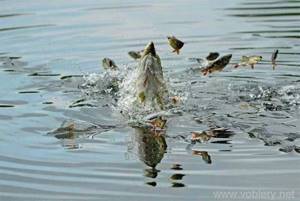
Fish move in large masses, grouping at various depths “according to the ranks of their dignity.” On the top floor, the smallest ones line the water; below, heavy, large roaches float, as if protecting the younger generation; the third floor is occupied by striped bass, and along the very bottom - this is the fourth floor - you can see some dark and long shadows in the clear water. This floor seems dead. But if you hold your attention longer, writes A. Onegov, you will definitely see how one or another shadow suddenly comes to life and easily moves a little forward, along the path of movement of the upper flocks. These are pikes.
“They sneak after the other inhabitants of the lake, sneak in short dashes, freeze, wait, come to life again, but almost never rush after the departing prey... But there is a rise in the bottom, a barely noticeable rise in front of a wide underwater shallow... There are plants and stones ahead. All three floors tend to the shallows. Here the pikes imperceptibly disperse in different directions. Now the vanguard of fish will reach the grass. Now the paths will leave their first floor and spread widely through the thickets of water lilies and pondweed, now the ripples will disappear and peaceful silence will come. But silence is not destined to fall near the underwater thickets... A second, two, three, now the tracks will go into the grass, but pikes are bursting out of the grass. The pikes, which were sneaking along the bottom, bypassed the prey in advance, ran ahead, set up ambushes, met their prey with attacks and scattered all three upper floors.”
From this description we can conclude that pike have adapted to flexibly change hunting tactics and strategies and move from stationary ambushes to hiding and mobile ambushes.
It must be said that there are many lakes where pike catch prey using active methods. An example is the well-known Pleshcheyevo (Pereyaslavskoye) Lake. This huge reservoir, with typical depths of 15-20 meters, has an insignificant zone of algae and other shelters (mainly boulders). There are a lot of pike here and, of course, there are not enough ambushes for everyone, and in winter there are even fewer shelters.
And when fishing with vertical lures from the bottom on this lake, there were such cases. The angler sits at the hole, trying to give the spoon the most seductive movements, which in the past caused bites, but there is no grip. Finally the fisherman's patience wears thin. He begins to reel in the reel to pull out the lure and change the fishing location. And suddenly, at that moment, when the bait is already raised to half the depth, there is a grip. And a minute later a pike appears in the hole, shaking its head, trying to free itself from the hook.
The repetition of such cases led local fishermen to a guess: some species of pike sometimes stay not at the bottom, but in the water column. And now “pikemen” in winter install gear on this lake in such a way that the bait swims at half-water.
Consequently, it can be assumed that in Lake Pleshcheyevo some pike obtain food in an active way, that is, by sneaking or chasing. This is all the more likely since vendace, which leads a pelagic lifestyle, is found in abundance in the lake.
And now I’ll tell you about several interesting cases when pike bites occurred under some special, rarely encountered circumstances. ...The spinners were throwing spoons into the cluttered pool near the dam. The place is right - there are a lot of pike, but no one got a bite. The hunt, apparently, would have gone on for a long time if the bait of one of the anglers had not caught on a snag. He walked for a long time from the shore to the dam and back, tugging the bait in different directions - to no avail: the long rod into which the hook grabbed, bent, allowing him to pull the lure two meters, and straightened out again. But finally, the spinner came unhooked, and the spinner pulled it to the middle of the pool. And suddenly a solid pike grabbed her.
What happened underwater? The monotonous wobbling movements of the spoon hanging on the rod apparently attracted the attention of the predator who was nearby. But the spoon, although it sparkled and trembled, still did not look like a living fish. But as soon as she broke away from the rod and “came to life,” the predator could not resist its grip.
...After the spawning of peaceful fish, juveniles are sometimes found, both battered and with traces of fresh wounds. This is the “job” of young pikes. Fed up with the food readily available during the spawning days of roach or other fish, predators do not reduce their aggressiveness and sometimes continue the hunt, driven by excitement. Sometimes their pursuit of fish is like a game between a well-fed cat and a caught mouse.
I have observed such “mischief” of young pikes more than once.
...On the Meta River I happened to meet a fisherman who, in an original way, lured pikes out of an impassable snag. It was easy to catch a pike in this snag, but getting it out of there was simply impossible. And the savvy fisherman found a way out of the situation: he installed his pole 8-10 m from the snag, and attached a net with bait to its pole.
Soon, fry and juvenile white fish gathered at the net. They splashed and pushed each other, trying to grab the food washed out of the net. This fuss quickly attracted the pike. At the moment of the predator’s sharp blow near the girder, the fish gathered at the feeder managed to scatter, and the live bait attached to the hook became its easy prey.
...An adult pike has keen eyes. Lying in ambush, it distinguishes prey in clear water at a distance of up to 2-2.5 m. This visibility limit is indicated in the scientific literature. However, in rivers with particularly clear water, if there are no waves or ripples on the surface, on reaches up to 1 m deep and a little more, the pike sees the bait 15-17 meters away.
Disguised on the shore, it is interesting to watch the pike attack the bait. When caught by a moving spoon, the pike seems to be taken aback, it goes crazy, starts shaking its head, and then, coming to its senses, rushes to the side.
If there is no grass or any other shelter nearby, the predator itself approaches the fisherman. She immediately jumps out of the water and for a moment seems to hang in the air, her mouth open, shakes her head, trying to throw out the spoon, and often she succeeds, especially if the bait is equipped with a large, insufficiently tenacious hook.
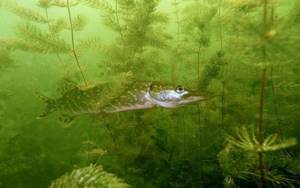
One day, walking along the Oka, not far from the Kopanovo pier, I saw someone installing a vent on the shore. To my surprise, instead of live bait, a light but rather large spoon spoon was attached to its line. The coastal stream either lifted it to the surface or lowered it to a depth of half a meter. This method of fishing seemed hopeless to me, but the owner of the gear approached and said: “The method, of course, is unusual, but, oddly enough, the pike grabs the spoon playing in the current. Probably because of curiosity and inexperience: after all, you come across more young pike.”
...Very often you hear from anglers that pike avoid fast currents. But on the reaches of some rivers adjacent to dams, locks, and riffles, this fish stays in those places where the current carries fry and juveniles, while it does not avoid the proximity of other predators - asp and chub.
I remember how at dawn of a July day we drove up to the well-known riffle on the Oka River near Novoselki, anticipating interesting fishing. But our hopes for it were immediately clouded: our friend, who had arrived here earlier, said that he only takes small pike perch on the tackle - there is no other fish.
We had no choice but to start catching live bait for the tackle. But, as always happens, where there are predators, it is almost impossible to catch small fish. With great difficulty I managed to catch one chub, and it turned out to be too big - more than 100 grams. Still, I decided to try and cast the fish on a rig. However, I didn’t calculate it correctly; the bait flew a little further than the target and fell straight onto the fast stream of the riffle. It was carried away by the current for about five meters, then, when, according to my calculations, it should have sunk to the bottom, I raised the tip of the rod and immediately felt a grip. And soon he brought out a large pike with a chub sticking out of its mouth.
Pike food
Pike is a predator, an exceptional meat eater. As soon as the egg hatches, it remains in place of the spawn for about two weeks until the yolk bubble completely disappears. Feeling hungry, it begins to actively move around the reservoir, choosing shallow places and feeding on invertebrates, as well as insects and worms. Already in June, squinting fish begin to hunt fry of other fish, most often perch and crucian carp, and by autumn their diet consists exclusively of fish. Shchury pups grow and develop rapidly, after a year their body reaches 15 cm in length, they gain weight up to 200 g, after a few years 42-45 cm and 700 g.
The diet of pike is dominated by fish, but for lack of anything better, it is not averse to feasting on small river birds, frogs and even rodents.
Most often, meals are taken in the morning and evening, while the day is reserved for rest and digestion of food. During zhora, individuals feed almost around the clock, hunting using lateral vision and a unique sense of smell.
The first zhor is associated with the pre-spawning period, most often falling at the end of February-beginning of March. But the second one is with the post-spawning period, which falls in May-early June. And finally, the third period of zhora, which falls in the fall.
Reproduction
Female pike begin to participate in reproduction from the age of 3-4 years, the body length of pike at this age is 35-40 cm, males participate in reproduction from the age of 5 years.
Pike is the very first freshwater fish to spawn; spawning begins in March immediately after the ice melts. The peak of spawning occurs during high water, when the water temperature is 3–6 degrees. In lakes and reservoirs, spawning occurs somewhat later, since the ice cover remains on them longer.
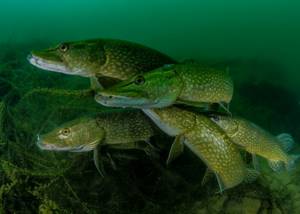
During spawning, pike goes aground and enters the mouths of small rivers and streams, lakes and water meadows. The depth of the water where spawning occurs is usually 0.5-1 meter. For spawning, pike choose places with a quiet current. Smaller pikes begin spawning, and the largest ones finish. Pike spawning can last up to 4 weeks. During spawning, pikes stay in groups, usually 2-4 males stay around one female; large females can keep up to 8 males.
During spawning, the female pike swims in front, and the males swim behind her, slightly behind her. Males either cling to the sides or stay above the back of the female. During spawning, the dorsal fins and backs of fish are constantly visible above the water. Constantly moving around the spawning area, pikes rub against bushes, roots, stems of reeds and cattails. Females lay eggs, and males fertilize them with their milk. As soon as the spawning is over, the pikes rush in different directions, making a loud splash, and the females often even jump out of the water.
You may be interested in: Kosadaka Wobblers
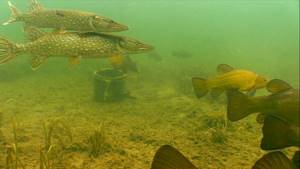
One female pike lays from 17.5 to 215 thousand eggs, the number of eggs in a female depends on her age and size. For example, a pike weighing 2.5 kg is capable of producing 136 thousand eggs. The pike egg has a diameter of about 3 mm. The eggs are sticky, due to which they attach to grass, algae and other underwater vegetation.
If after the spawning of pike there is a rapid decline in water, then most of the eggs dry out and die.
After 2-3 days, the stickiness of the eggs disappears and they fall to the bottom, where a larva, 6.7-7.6 mm long, develops from it within 8-14 days. The rate of development of the larvae from the eggs depends on the temperature of the water in the reservoir.
As the bubble dissolves, pike larvae begin to feed on zooplankton, small crustaceans and begin to grow rapidly. The pike larva, with a length of only 12-15 mm, is already beginning to prey on the larvae of carp fish. Spawning of carp fish occurs much later than the spawning of pike; cyprinid larvae become food for young pike.
Pike fry begin to eat insects, worms, eggs and fish larvae, and having reached a length of 5 cm, they begin to hunt and completely switch to feeding on small fish.
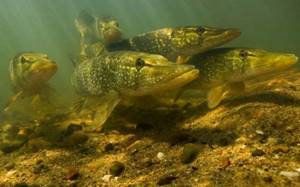
Pike fry often become prey for other predatory fish, birds and animals. Adult pike and pike perch happily eat small pike perch. Among the birds there are ducks and seagulls, and among the animals the muskrat is also not averse to feasting on small bee-eaters.
Pike fry grow quite quickly, being born in April-May, by autumn they grow up to 15 cm and weigh about 100 grams. The growth of pike fry depends on the availability of food supply. In reservoirs with a rich food supply, pike at the age of 1 year reaches a length of 30 cm, and a pike at the age of 2 years reaches a length of 40 cm and weighs about 1 kg. The older the pike gets, the slower it grows in length, but the faster it gains weight. Pike at the age of 5 years gains only 2 cm in length per year.

It happens that pikes enter flood lakes in the spring, after a while the water subsides, the connection between the lake and large water is interrupted and the pikes find themselves locked in such a reservoir. In such a locked reservoir, pike experience a lack of food resources, the growth of pike here is very uneven, pike of the same age differ in length by 2 - 2.5 times.
In such a reservoir, pike fry feed on zooplankton, larger pikes feed on pike fry, and the largest pikes feed on medium-sized pikes. Reservoirs of this type are often found in Yakutia and Canada.
Pike fishing methods

Modern fishermen skillfully master various methods of catching pike, but we will focus on the most effective:
- Spinning - for catching pike with a spinning rod, the most successful period is the beginning of autumn - active fishing. Riffles, whirlpools, and areas of algae thickets are the best places for fishing in this case. Modern fishing rods and a variety of baits presented in specialized stores allow you to achieve amazing results.
- Jig spinning - recently, catching pike with jig bait has become increasingly popular. And all because it allows you to cover a body of water with differences in depth. Stepped wiring allows you to explore every meter of the reservoir area. By the way, when fishing, be sure to increase the falling stage of the bait, since pike are more attracted to horizontal prey.
- Wobblers for pike - perhaps the best bait these days are considered to be wobblers, ideal for reservoirs with a flat bottom. In this case, the bait should be led with short intermittent movements with timely rewinding of the fishing line. Only then will you be able to wait for the bite.
- Using live bait - some anglers still prefer the classic method of fishing, that is, using live bait. Mugs and girders are the best helpers in this case. The mugs are installed from the boat, and the girders are fixed on overhanging bushes, or less often trees. Rewinding of the fishing line occurs at the moment the pike grabs the live bait. A special signal for the fisherman is to turn the circle over. The wires, on the contrary, need to be checked periodically, which is not entirely convenient.
- Trolling - in pursuit of trophy pike in a spacious reservoir, it is better to use a motor boat. Several spinning rods are thrown into the water at the same time, which allows for maximum catch. In addition to fishing rods and tackle, do not forget to purchase an echo sounder that guides the boat along the most promising place.
Pike lures
Pike fishing is an exciting and incredibly interesting activity. But in many ways, the result of fishing depends on how carefully you approach the choice of bait for pike. Spinning fishing has its roots since the beginning of the last century, during which time it has undergone many changes and has been able to improve.
The baits on the market are literally eye-opening:
- Spoons are the most popular type of truly effective and affordable bait, but choosing the best option, especially for a beginner, is not at all easy. It is for this reason that it is better to acquire a whole set of spinners in order to determine the most successful one through practical measures. The main selection criteria are weather conditions and light level: in sunny, clear weather it is recommended to use white, inconspicuous spinners; in cloudy weather, rich yellow spinners are most effective; in partly cloudy weather, it is better to combine both options.
- Wobblers are a modern alternative to spinners that have become popular in the last few years. This success is primarily ensured by the huge range and variety of models on the market. When choosing the best option, you should start from the usual diet of fish.
- Jig baits are in most cases suitable for various types of ripples, which is why they are loved by many anglers. But when choosing bait for pike fishing, you should give preference to options that sink rather slowly to the bottom. In addition, the jig bait must be quite large and bright so that the predator turns its attention to it.
{banner_vnutri-kontenta-3}
How do you catch pike?
You can read more about how to catch pike in other articles in this section. In general, pike is a desirable object for any angler, and thanks to its greed, it is quite easy to catch it. It is also interesting that this fish, once hooked, usually behaves very violently, so catching large specimens is not easy, but that is precisely why they are so desirable.
Pike can be caught using spinning rods, circles, tracks, girders, trolling, and winter fishing rods. Less often it is caught with a regular float rod or on a donkey.
There is a lot of advice out there regarding the best choice of lures for pike or live bait, but the truth is that there is no best option. Experienced fishermen know that in the same body of water you can catch a lot with one lure on one day, and nothing on another day. And there are days when this fish will very greedily grab any bait. Its behavior depends on the weather and other factors that are individual for each body of water. That is, it is possible to give general recommendations, but it is far from certain that they will work on a specific day and on a specific body of water.
Pike dishes
Pike is a predator, which gives its meat a certain taste. A large amount of gluten gives pike dishes a special thick consistency. But there is one drawback - a specific taste, which not everyone will like. The taste, by the way, largely depends on the habitat of the individual and its diet. However, you can get rid of it if you know some cooking secrets.
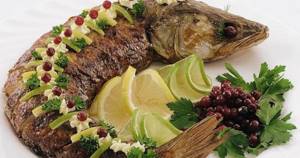
In traditional cuisine, pike is given a special place, since it is a common fishery in various latitudes. Pike is used to make fish soup, aspic, stuffed with mushrooms, fried and baked; pike makes excellent cutlets and zrazy. Pike loves spices and spices and goes well with basil, garlic, rosemary and mustard, honey, bay leaves and even green onions. The nature of the finished dish will depend on what spices and in what quantities are added. It is better to use olive oil for cooking pike, or at least butter.
Appearance
Pike body
The pike has a torpedo-shaped elongated body, with fins shifted towards the tail. The whole appearance of the pike speaks of its ability to develop high speed with lightning speed.
Pike fins have a rounded shape, their whole appearance speaks of the excellent hydrodynamic properties of the pike. A long body with large dorsal and anal fins and a muscular tail give the pike the ability to move quickly. True, it can only pursue its prey in short bursts.
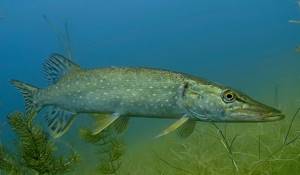
The pike has a large, elongated head, a wide mouth, and the lower jaw protrudes slightly forward.
The pike's snout is wide and elongated, somewhat reminiscent of the muzzle of a crocodile. The pike's mouth has a large gripping area; the gill membranes are separated from each other, allowing the pike to open its mouth very wide. Thanks to this, the pike can swallow food of large sizes, up to 2/3 of its own length. Fishermen know this feature of pike, so they often use large baits when fishing for pike.
The entire body of the pike is covered with small scales closely adjacent to each other, which form a dense monolithic cover that reliably protects the body of the pike from the teeth of other pikes.
Body coloring
Pike differ greatly from each other in color. The color can be very different and depends on the age of the pike, the aquatic environment, food supply and other environmental conditions.
The main color of pike scales is gray-green; spots of different shades from yellowish and olive to brown are scattered on a gray background. The spots form transverse stripes on the sides of the pike. The back of the pike is dark, the belly is light yellow or grayish-white.
The coloring of pike has an important camouflage function. A camouflage pattern of transverse stripes and spots scattered throughout the pike’s body makes the pike invisible in the pond. The camouflage pattern on the pike’s body is especially effective in areas with dense vegetation and snags.

The color depends on the age of the pike: young pikes have a lighter color, adults have a darker body color.
The color of pikes greatly depends on their habitat. Pike living in peat and silted reservoirs have a dark body color. Pike living in reservoirs with clear water and a sandy bottom are light in color. Pike living among underwater vegetation, the so-called grass fish, have a greenish body color.
The paired fins of pike are orange or red, the unpaired fins are yellowish-brown, brown or gray with light streaks and stripes.
Females and males of pike do not differ in body color. The female differs from the male in the larger size and shape of the urogenital opening. The urogenital opening of a female pike is an oval depression surrounded by a pink ridge, and in males it looks like a narrow oblong slit.
Mouth, vision, sense organs
The pike has good eyesight, its wedge-shaped snout is designed in such a way that the high-set eyes of the pike allow it to see very well what is in front of it, above it, on the sides of it and even just below it if the object is slightly ahead.
The wide mouth prevents the pike from seeing objects that are below it at a close distance.

Pike have binocular vision and can well determine the distance to moving objects and the speed of their movement. Scientists' experiments show that pike can distinguish more than 20 color shades.
Pike has a well-developed olfactory apparatus, thanks to which at certain periods it can feed on carrion from the bottom of the reservoir.
The pike has a well-developed lateral line organ. Thanks to this organ, pike can hunt even in muddy water and detect the source of the slightest fluctuations in water from a great distance.
Experiments show that even a completely blind pike can successfully obtain food for many years, precisely thanks to the lateral line organ.
Predator teeth and their replacement
The pike's huge mouth is lined with sharp teeth. All pike teeth are not used for chewing food, but for capturing and killing prey. Some of the teeth are located on the jaws; they look like sharp fangs of different sizes, located at some distance from each other.
In addition to the fangs, on the jaws, palate, tongue and cheeks of the pike there are bristle teeth that resemble the bristles of a toothbrush in appearance. The bristle teeth are directed with their sharp ends towards the pharynx and in the normal state are immersed in the mucous membrane. These teeth help the pike hold on and make it easier to swallow prey. When the prey tries to escape from the mouth, the bristle teeth rest against it with their tips and do not allow it to slip out, pushing the prey further into the throat.

There is a legend among fishermen that after spawning and during the full moon, the pike’s teeth change and because of this it stops feeding and is not caught at this time.
In fact, the change of teeth in pike is a continuous process that occurs constantly throughout the life of the pike. The change of teeth in pike has no connection with spawning and the full moon. The passivity of pike and the lack of biting is not associated with a change of teeth, but is explained by a loss of strength due to spawning.
Each tooth in the lower jaw of a pike is adjacent to 2-4 replacement teeth, which are hidden under the soft tissue of the inner surface of the jaw. The active tooth and its replacement teeth together form a dental family. When a pike's working tooth goes out of use, its place is taken by a replacement tooth; at first it is soft and not very stable, but then its base grows to the pike's jaw and becomes strong.
You may be interested in: Sunline Small Game PE Braided Cord
The change of teeth does not occur simultaneously in pike. If you examine the teeth of a caught pike, you will see old, dissolving teeth, strong working teeth, and new, still mobile, young teeth.
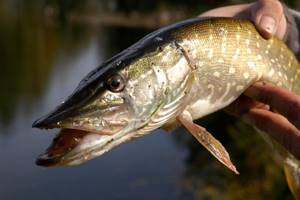
The sharp teeth of a pike can cause a lot of trouble for inexperienced fishermen who have not yet learned how to properly handle the caught fish. Even a scratch from the small teeth of a small pike is very painful and does not heal for a long time. In addition to the teeth, the sharp edges of the pike's gill covers, which can easily cut oneself, pose a danger to the fisherman.
You need to remove the caught pike from the water with a special landing net. Before handling a pike, it is advisable to wear gloves with a protective coating. To remove the bait from the pike's mouth, its mouth is securely fixed with a gaper, and the bait itself is removed with an extractor, while the pike's head is carefully held with one hand under the gills, pressing it against a hard surface.
